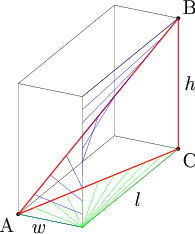Difference between revisions of "1986 AIME Problems/Problem 14"
(solution by minsoens) |
m |
||
| Line 3: | Line 3: | ||
== Solution == | == Solution == | ||
| − | + | <center>[[Image:AIME_1986_Problem_14_sol.png]]</center> | |
| − | In other | + | In the above diagram, we focus on the line that appears closest and is parallel to <math>BC</math>. All the blue lines are perpendicular lines to <math>BC</math> and their other points are on <math>AB</math>, the main diagonal. The green lines are projections of the blue lines onto the bottom face; all of the green lines originate in the corner and reach out to <math>AC</math>, and have the same lengths as their corresponding blue lines. So we want to find the shortest distance between <math>AC</math> and that corner, which is <math>\frac {wl}{\sqrt {w^2 + l^2}}</math>. |
| − | |||
| − | |||
| − | <math>\frac { | ||
So we have: | So we have: | ||
| Line 21: | Line 18: | ||
<cmath>\frac {h^2l^2}{h^2 + l^2} = \frac {1}{\frac {1}{h^2} + \frac {1}{l^2}} = \frac {45}{2}</cmath> | <cmath>\frac {h^2l^2}{h^2 + l^2} = \frac {1}{\frac {1}{h^2} + \frac {1}{l^2}} = \frac {45}{2}</cmath> | ||
| − | We | + | We invert the above equations to get a system of linear equations in <math>\frac {1}{h^2}</math>, <math>\frac {1}{l^2}</math>, and <math>\frac {1}{w^2}</math>: |
<cmath>\frac {1}{l^2} + \frac {1}{w^2} = \frac {45}{900}</cmath> | <cmath>\frac {1}{l^2} + \frac {1}{w^2} = \frac {45}{900}</cmath> | ||
<cmath>\frac {1}{h^2} + \frac {1}{w^2} = \frac {13}{900}</cmath> | <cmath>\frac {1}{h^2} + \frac {1}{w^2} = \frac {13}{900}</cmath> | ||
<cmath>\frac {1}{h^2} + \frac {1}{l^2} = \frac {40}{900}</cmath> | <cmath>\frac {1}{h^2} + \frac {1}{l^2} = \frac {40}{900}</cmath> | ||
| − | <math>h = 15</math>, <math>l = 5</math>, <math>w = 10</math> | + | We see that <math>h = 15</math>, <math>l = 5</math>, <math>w = 10</math>. Therefore <math>V = 5 \cdot 10 \cdot 15 = 750</math>. |
== See also == | == See also == | ||
Revision as of 13:31, 6 October 2007
Problem
The shortest distances between an interior diagonal of a rectangular parallelepiped, ![]() , and the edges it does not meet are
, and the edges it does not meet are ![]() ,
, ![]() , and
, and ![]() . Determine the volume of
. Determine the volume of ![]() .
.
Solution

In the above diagram, we focus on the line that appears closest and is parallel to ![]() . All the blue lines are perpendicular lines to
. All the blue lines are perpendicular lines to ![]() and their other points are on
and their other points are on ![]() , the main diagonal. The green lines are projections of the blue lines onto the bottom face; all of the green lines originate in the corner and reach out to
, the main diagonal. The green lines are projections of the blue lines onto the bottom face; all of the green lines originate in the corner and reach out to ![]() , and have the same lengths as their corresponding blue lines. So we want to find the shortest distance between
, and have the same lengths as their corresponding blue lines. So we want to find the shortest distance between ![]() and that corner, which is
and that corner, which is ![]() .
.
So we have:
![]()
![]()
![]()
Notice the familiar roots: ![]() ,
, ![]() ,
, ![]() , which are
, which are ![]() ,
, ![]() ,
, ![]() , respectively. (This would give us the guess that the sides are of the ratio 1:2:3, but let's provide the complete solution.)
, respectively. (This would give us the guess that the sides are of the ratio 1:2:3, but let's provide the complete solution.)
![]()
![]()
![]()
We invert the above equations to get a system of linear equations in ![]() ,
, ![]() , and
, and ![]() :
:
![]()
![]()
![]()
We see that ![]() ,
, ![]() ,
, ![]() . Therefore
. Therefore ![]() .
.
See also
| 1986 AIME (Problems • Answer Key • Resources) | ||
| Preceded by Problem 13 |
Followed by Problem 15 | |
| 1 • 2 • 3 • 4 • 5 • 6 • 7 • 8 • 9 • 10 • 11 • 12 • 13 • 14 • 15 | ||
| All AIME Problems and Solutions | ||









